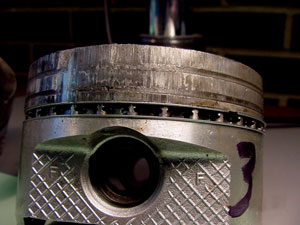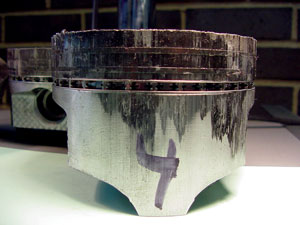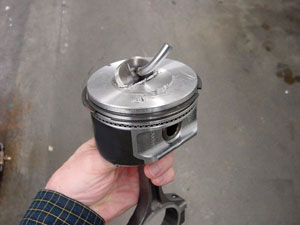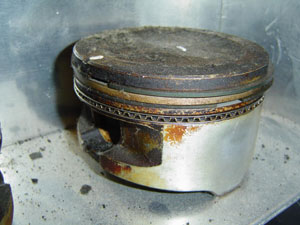h loads cause microwelding between the rings and lands, resulting in rapid land wear.
Sometimes a wrist pin will work loose and chew into the cylinder with each stroke of the piston. The underlying cause here may have been improper installation of the retaining lock rings on a full floating wrist pin, improper fit or installation of a pressed-in wrist pin, a twisted or bent connecting rod, excessive thrust end play in the crankshaft or taper wear or misalignment in the crankshaft rod journal.
 When to Replace
When to Replace
Any pistons that are worn or damaged must be replaced. In most cases, if one piston is bad, the others are too so all would be replaced as a complete set. Many pistons that appear to be in good condition and show no signs of scuffing may still have to be replaced because the upper ring lands are worn. If a piston with worn ring lands is reused, the rings won’t seal properly and the engine will use oil. Wear or looseness in the wrist pin area would also call for replacement.
 Another reason to replace pistons would be to change the stock compression ratio (as when using different heads, aftermarket heads or when building a performance motor), or to increase engine durability. Stock cast pistons are fine for everyday driving, but may lack the strength to handle higher than stock horsepower in a modified engine.
Another reason to replace pistons would be to change the stock compression ratio (as when using different heads, aftermarket heads or when building a performance motor), or to increase engine durability. Stock cast pistons are fine for everyday driving, but may lack the strength to handle higher than stock horsepower in a modified engine.
Upgrading to hypereutectic pistons or forged pistons in such a case would probably be necessary.
The safest bet is to replace pistons with ones that are the same material as the original, or better. Many late-model engines today are factory-equipped with hypereutectic pistons. Switching to cheaper cast pistons may be asking for trouble.
Hypereutectic pistons have a higher silicon content (typically 16 to 20 percent versus 8 to 11 percent for a standard piston), which makes them harder, more wear resistant and much stronger than ordinary cast alloys.
Consequently, hypereutectic pistons are better able to resist ring pound out and scuffing. They also expand less than standard cast alloys, which allows them to be assembled with closer tolerances (helps reduce noise).
 HP and Severe Duty
HP and Severe Duty
For high performance, severe service or heavy-duty applications, hypereutectic or forged pistons are usually required. Forged pistons may contain almost no silicon up to 11.5 percent, depending on the alloy and application.
 The important difference here is the way forged pistons are made: they are forged under high pressure rather than cast. The forging process increases the density of the metal and significantly improves its strength (up to 40 percent or more over conventional cast pistons). Forging also increases cracking resistance, and may allow a piston to survive a close encounter with a valve without shattering. Forged pistons generally run 18 to 20 percent cooler than cast pistons, too, which is a plus in high heat or performance applications. Because of these differences, forged pistons are usually the preferred choice for turbocharged, supercharged engines, and those running nitrous oxide.
The important difference here is the way forged pistons are made: they are forged under high pressure rather than cast. The forging process increases the density of the metal and significantly improves its strength (up to 40 percent or more over conventional cast pistons). Forging also increases cracking resistance, and may allow a piston to survive a close encounter with a valve without shattering. Forged pistons generally run 18 to 20 percent cooler than cast pistons, too, which is a plus in high heat or performance applications. Because of these differences, forged pistons are usually the preferred choice for turbocharged, supercharged engines, and those running nitrous oxide.
Some people think that the same thermal characteristics that allow forged pistons to run cooler also causes them to swell more as they heat up. Consequently, there’s a common misconception that forged pistons always require greater skirt-to-wall clearances – a notion that is not necessarily true because clearances depend on the type of alloy that is used in a forged piston, the design of the piston itself the application in which the piston will be used.
Some forged alloys actually have a lower coefficient of thermal expansion than the alloys commonly used in conventional cast pistons!
One way to control thermal expansion in a piston is to manufacture it so the piston is slightly elliptic rather than round. The diameter of most pistons (forged as well as cast) measures anywhere from .010” to .035” shorter across the wrist pin axis than the diameter perpendicular to the pin (the “major” axis). This compensates for the greater mass in the wrist pin area which causes the piston to swell sideways as it heats up. This allows the piston to fill the hole as it heats up for a tighter all-round seal.
Handling the Heat
Piston growth is also influenced by the temperature differential between the top and bottom of the piston. The top can be 300° F or more hotter than the bottom. Since the top runs hotter and swells more than the bottom, growth can be controlled by making the skirt profile taper in towards the top.
The typical piston is widest at the bottom of the skirt and narrowest at the top (which is why it is so important to always measure a piston at the location specified by the piston manufacturer, which may be either perpendicular to the pin at the pin centerline, one inch up from the bottom of the skirt or at the top of the skirt).
When all these factors are taken into consideration, there can be considerable differences in recommended minimum skirt clearances between various brands of forged pistons. In some applications (such as a low compression, moderate horsepower output engine), a forged piston may be installed with the same clearances as an OE cast piston. In other applications (high compression, high power output), the pistons may need additional clearance.
Whether the piston has a coated skirt (and what kind of coating) will also affect the recommended clearance. Coatings are applied to prevent dry starts and scuffing, and to protect the piston and cylinders in case the engine loses lubrication. Most engines today have very tight piston-to-wall clearances (.001? or less) to minimize blowby and reduce piston rock. With a coating, the clearance may be reduced even more, and some coated pistons may actually be installed with zero clearance!
Next Month, we’ll take a look at a major influencer to the masterpiece engine – the piston rings.


